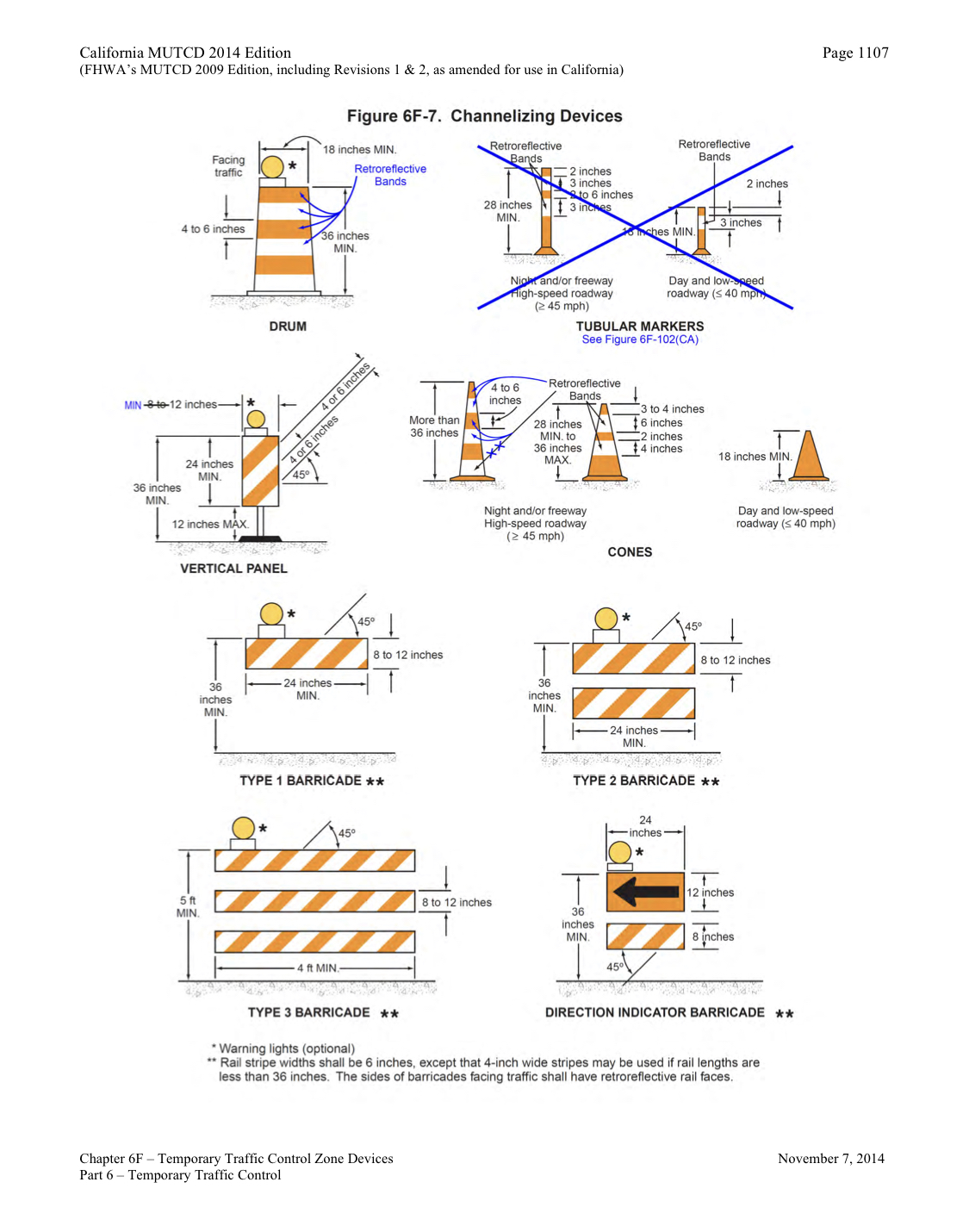What is the difference between Type I, II, and III barricades? The major difference is the surface area of retroreflective material, and therefore the visibility of the barricade.
From the CA MUTCD, minus formatting:
Section 6F.68 Type 1, 2, or 3 Barricades
Support:
01 A barricade is a portable or fixed device having from one to three rails with appropriate markings and is used to control road users by closing, restricting, or delineating all or a portion of the right-of-way.
02 As shown in Figure 6F-7, barricades are classified as Type 1, Type 2, or Type 3.
Standard:
03 Stripes on barricade rails shall be alternating orange and white retroreflective stripes sloping downward at an angle of 45 degrees in the direction road users are to pass. Except as provided in Paragraph 4, the stripes shall be 6 inches wide.
Option:
04 When rail lengths are less than 36 inches, 4-inch wide stripes may be used.
Standard:
05 The minimum length for Type 1 and Type 2 Barricades shall be 24 inches, and the minimum length for Type 3 Barricades shall be 48 inches. Each barricade rail shall be 8 to 12 inches wide. Barricades used on freeways, expressways, and other high-speed roadways shall have a minimum of 270 square inches of retroreflective area facing road users.
Support:
05a The Type I and Type II Barricades, 36 inch in length with each rail 12 inch wide, provide additional conspicuity in visually complex environments and for older road users.
Standard:
05b On State highways, the retroreflectorized bands shall be maintained at or above minimum levels in Table 2A-3.
Guidance:
05c On local roads, the retroreflectorized bands should be maintained at or above minimum levels in Table 2A-3.
Support:
05d Refer to Caltrans’ Standard Specifications Section 12-3.01A(4) for visibility criteria cited. See Section 1A.11 for information regarding this publication.
Guidance:
06 Where barricades extend entirely across a roadway, the stripes should slope downward in the direction toward which road users must turn.
07 Where both right and left turns are provided, the barricade stripes should slope downward in both directions from the center of the barricade or barricades.
08 Where no turns are intended, the stripes should be positioned to slope downward toward the center of the barricade or barricades.
09 Barricade rails should be supported in a manner that will allow them to be seen by the road user, and in a manner that provides a stable support that is not easily blown over or displaced.
10 The width of the existing pedestrian facility should be provided for the temporary facility if practical. Traffic control devices and other construction materials and features should not intrude into the usable width of the sidewalk, temporary pathway, or other pedestrian facility. When it is not possible to maintain a minimum width of 60 inches throughout the entire length of the pedestrian pathway, a 60 x 60-inch passing space should be provided at least every 200 feet to allow individuals in wheelchairs to pass.
11 Barricade rail supports should not project into pedestrian circulation routes more than 4 inches from the support between 27 and 80 inches from the surface as described in Section 4.4.1 of the “Americans with Disabilities Act Accessibility Guidelines for Buildings and Facilities (ADAAG)” (see Section 1A.11).
Option:
12 For Type 1 Barricades, the support may include other unstriped horizontal rails necessary to provide stability.
Guidance:
13 On high-speed expressways or in other situations where barricades may be susceptible to overturning in the wind, ballasting should be used.
Option:
14 Sandbags may be placed on the lower parts of the frame or the stays of barricades to provide the required ballast.
Support:
15 Type 1 or Type 2 Barricades are intended for use in situations where road user flow is maintained through the TTC zone.
Option:
16 Barricades may be used alone or in groups to mark a specific condition or they may be used in a series for channelizing road users.
17 Type 1 Barricades may be used on conventional roads or urban streets.
Guidance:
18 Type 2 or Type 3 Barricades should be used on freeways and expressways or other high-speed roadways. Type 3 Barricades should be used to close or partially close a road.
Option:
19 Type 3 Barricades used at a road closure may be placed completely across a roadway or from curb to curb.
Guidance:
20 Where provision is made for access of authorized equipment and vehicles, the responsibility for Type 3 Barricades should be assigned to a person who will provide proper closure at the end of each work day.
Support:
21 When a highway is legally closed but access must still be allowed for local road users, barricades usually are not extended completely across the roadway.
Standard:
22 A sign shall be installed with the appropriate legend concerning permissible use by local road users (see Section 6F.09). Adequate visibility of the barricades from both directions shall be provided.
Option:
23 Signs may be installed on barricades (see Section 6F.03).
24 Barricades may be used as sign supports if the barricades have been successfully crash tested as one unit with a construction area sign attached.
